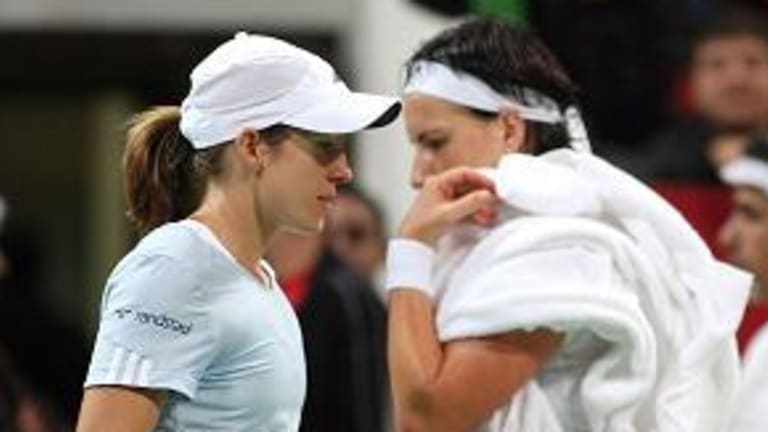Howdy, everyone. It's good to be back; I missed you all! Today was catch-up day after a wonderful trip to Belize; I'll write about for the Wednesday Racket OT thread. In other housekeeping matters, Steggy and I will be posting some potentially useful information for all of you who are coming to Indian Wells (that also will be on Wednesday, in a separate entry). So tune in then, for sure.
Burial at Sea
By Peter Bodo Mar 05, 2007Indian Wells, USA
Novak Djokovic played like a mortal in Indian Wells loss—and sounded like one afterwards
By Steve Tignor Mar 09, 2025Pick of the Day
Indian Wells Betting Preview: Clara Tauson vs. Mirra Andreeva
By Zachary Cohen Mar 09, 2025Indian Wells, USA
Aryna Sabalenka wins Indian Wells opener over McCartney Kessler
By David Kane Mar 09, 2025Indian Wells, USA
Tsitsipas takes on Berrettini; Swiatek and Andreeva feature: Indian Wells, Day 5 Preview
By Steve Tignor Mar 09, 2025Indian Wells, USA
Novak Djokovic falls to Botic van de Zandschulp in opening match at Indian Wells
By John Berkok Mar 09, 2025Indian Wells, USA
Coco Gauff snaps losing streak with gritty Indian Wells victory over Moyuka Uchijima
By TENNIS.com Mar 08, 2025Social
Frances Tiafoe forgets his racquets in funny pre-match Indian Wells scene
By Baseline Staff Mar 08, 2025Indian Wells, USA
Carlos Alcaraz wins to start 2025 Indian Wells title defense
By David Kane Mar 08, 2025Your Game
Shoe Review: Nike Air Zoom Vapor 12
By Jon Levey Mar 08, 2025Burial at Sea
Published Mar 05, 2007
Advertising

Jbtco
© 2007 Getty Images
I wrote my ESPN blog item today about the women's field at Indian Wells; I also take it from the recent headlines and the discussion here at TennisWorld that the James Blake/Yevgeny Korolev incident in Las Vegas emerged as the biggest story of the week that I was away.
A comparison of the two disparate issues tells us quite a bit about the state of the respective tours at an intriguing juncture in the evolution of the pro game.
The women's ship of state, as the skeleton crew manning the oars at Indian Wells can attest, is taking on water, and fast. This is from a buffeting that the game is taking from a few different directions.
The first source of stress is geopolitical. With the American presence among the players in precipitous decline, players and the suits who love them sense an opportunity to broaden the base of the game and invite new players to the table. They love phrases like "growing the game" and wax enthusiastic about emerging new tennis markets. In fact, the WTA's still-evolving Roadmap for the Future started out as a bold initiative to create a more streamlined tour that was less taxing on the players (physically) and better representative of the increasingly global nature of the game. That is, the WTA feels it needs to exploit new markets in world where U.S. power, as expressed in players, seems to be waning and "globalization" is a mantra.
I wrote a little about this a week ago, and am still preparing a lengthy post on the Roadmap for the near future (details of the Roadmap will probably be announced at Key Biscayne). But for now I'll say that the main challenge for the WTA is to shape a game that is driven by a long-term vision rather than a short-term strategy for pleasing the well-hidden wild card in these negotiations, a wealthy, powerful tour sponsor (in this case, Sony Ericsson). You have to be aware of an important distinction - and potential point of friction - here. Using tennis to help a sponsor penetrate certain markets is very different from helping the game flourish and grow.
In fact, here's something to consider: In the explosive 1970s an 1980s, when tennis went big-time, the game was dominated by players from the U.S. and the preponderance of significant events took place in the U.S. It's counter-intuitive, but I see no correlation between growing the game and taking the tour to an increasing number of places (much as I love that concept at an ideological level). And here's something else: for all the grief Americ- whoops, gringos - get about their arrogance and dominance, the U.S. audience is far, far more likely than anyone, save the British, to accept a game in which its own competitors are a diminishing factor. Just read the comments at this blog to see how open most Americans are to the international cast of tennis.
Beyond that, the only proportional link I see between the popularity of the game and specific nations is the number of top players the nation has contributed to the pool of pros. That is, when it comes to "growing the game" or increasing "globalization", I'll take one Paradorn Srichaphan over 10 ATP events staged in Thailand (with no Thai competitors), any day. When Steffi Graf and Boris Becker were in their prime, tennis reigned supreme in Germany - at one point, revenues from German broadcasters accounted for a mind-boggling 90 per cent-plus of the ATP's revenue. Today, the game is hardly on the radar in Germany, Tommy Haas and Nicolas Kiefer non withstanding.
Another force buffeting the WTA has been a remarkable decline in player commitment to the Game, with a capital "G". For reasons of varying legitimacy, the divas are in charge of the asylum. Many of them seem to do exactly what they want, at any given time, with no sense of obligation or responsibility to a larger cause. This relegates to the realm of wishful thinking the popular meme that the real problem in the game is an overburdened calendar. If that's the case, then tennis players are truly unique. In what other profession do workers bitterly complain about too much opportunity? Damn! Some producer just called, wanting me to do his picture, while I was on the line about a project with Marty Scorsese. There's the problem with the film industry, there's too much business. What's wrong with these people! Fewer pictures, that's what we need!
Advertising

Henindoha
© AFP/Getty Images
The poor field at Indian Wells is an an example of a less personal and deeper commitment problem, one made glaring by a unique situation, Venus and Serena Williams ongoing boycott of Indian Wells (it stems from an ugly incident there a few years ago; just Google it).
But in playing (and winning) Dubai and Doha back-to-back and skipping Indian Wells, Justine Henin essentially turned a cold shoulder on one of the great tournaments - an event that has nursed the women's game to the point where a Dubai or Doha can exist. But Henin's loyalty is to the cart, not the horse - presumably for the same reason that John Dillinger robbed banks: because that's where the money is! Hey, she's free to do what she wants, but this underscores the instability that is a growing feature of the women's game.
Indian Wells is the fifth among the tournaments of the world in attendance (270,000 in 2006), and one of better vehicles for promoting the game.
Roadmap, schrodenap, the bottom line is that the game needs a hierarchy of events, and something will always determine where various tournaments fit into it. You don't like tradition, fine. What do you propose as an alternative basis for status, because one will be imposed or emerge. Should it be money?
I have one very simple question to ask of the WTA, and I wish I had thought of it when I had Larry Scott on the phone the other day: Why don't you just embrace the ATP's Masters Series concept, and grandfather in the tournaments that have proven to be most useful in promoting that game? And the way to determine that is not through prize-money or sponsorship revenues, that would again be a horse and cart equation. Judge it by an event's history in the game, vis a vis the number of fans it attracted and the degree of exposure it generated. Then demand a certain level of sponsorship and prize-money as the price of a seat at that special table. Make the big Masters - Mistress? - events mandatory and forget about the rest.
Now let's look at incident that ATP CEO Etienne de Villiers so accurately described as a "tempest in a teacup." The Blake/Korolev brouhaha (see the Monday Net Post for relevant links) demonstrated two things: de Villiers first instincts are those of a marketing man (and there's no crime in that, just keep him a way from the gun cabinet!), and his disastrous reaction to the crisis in Las Vegas showed a curious combination of leadership and poor judgment (he completely misunderstood the sanctity of playing by the rules). But I'll give him a pass, because he's still learning on the job. And what's that wonderful quote by Teddy Roosevelt? In any moment of decision, the best thing you can do is the right thing, the next best thing is the wrong thing, and the worst thing you an do is nothing. . .
I was astonished that the events unfolded as they did in the first place, because giving the nod to Korolev over Blake seemed like a no-brainer. So I have to assume that the incident was driven by the power of Blake's personality and appeal. He was aggrieved; something had to be done out of deference to his clout and reputation. Would anyone have called de Villiers if it were a matter of Korolev or Chela getting the nod to move on?
The saving grace in all this is that we just saw the final nail driven into the coffin of round robin, a format that has a unique ability to blow up in our collective face, no matter how carefully the administrators try to fine-tune the rules. That should tell you something. I say round robin gets a burial at sea; and I know just the boat from which you can chuck the coffin. Still, the ATP's problems seem almost cosmetic (at least in this discussion), while the WTAs problems seem precariously foundational. Wear your noreaster', fans.